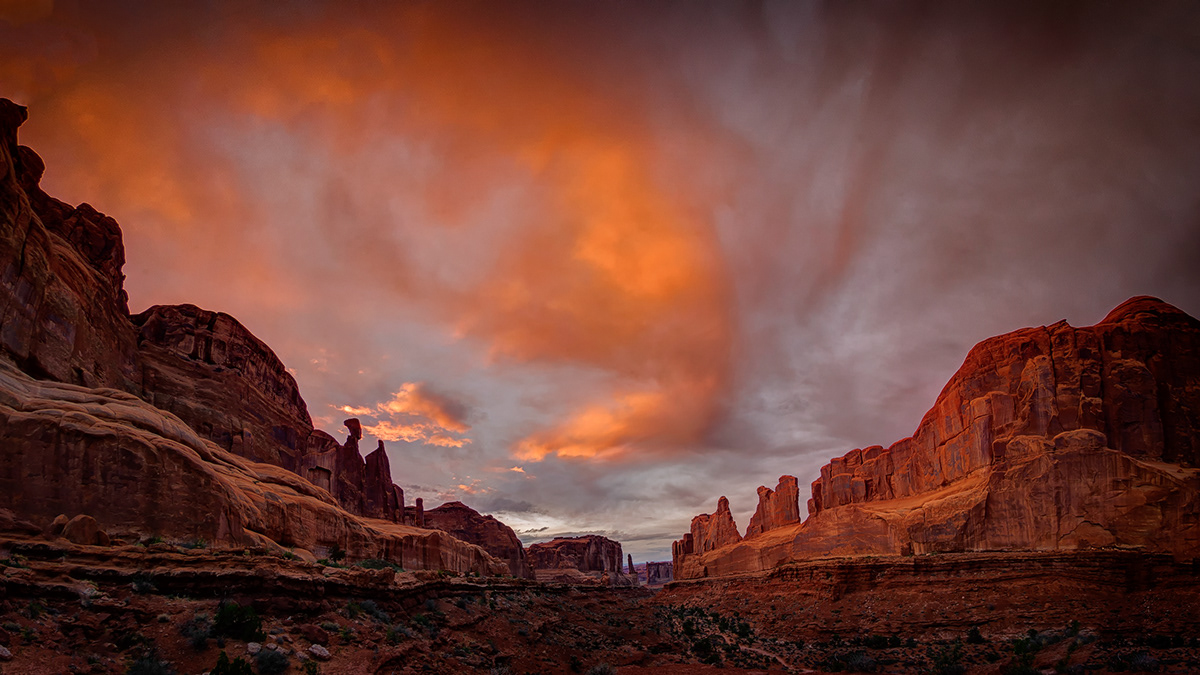
Sunset on Park Avenue by Jeff Burton. The sun lights up the sky with a golden orange light over Park Avenue in Arches National Park outside Moab Utah. The Park Avenue Trail is seen extending from the bottom of the image to the gap in the rock walls. The rock wall formations tower above the viewer of either side of the trail and the red sandstone is enhanced by the orange light reflecting from the clouds in the sky.
“After an entire day of traveling on planes, trains, and automobiles, we arrived at Park Avenue just before sunset. It was a scramble to dig all the photography gear out of the van and I rushed up to the lookout point to catch the last bit of sunset. To avoid having spectators in the image, I walked down the Park Avenue Trail for about 100 yards to a relatively level spot to make this image.”

Moonrise over North Window Arch by Jeff Burton represents the moon rising over the North Window Arch just after sunset in Arches National Park outside Moab, Utah. The deep blue color of the sky after sunset casts a faint glow on the landscape below while the bright moon helps guide the remaining hikers to their final destinations.

Delicate Arch II by Jeff Burton. Delicate Arch is a 65-foot (20 m) tall freestanding natural arch located in Arches National Park near Moab, Utah. It is the most widely-recognized landmark in Arches National Park and is depicted on Utah license plates and on a postage stamp commemorating Utah's centennial anniversary of statehood in 1996. The Olympic torch relay for the 2002 Winter Olympics passed through the arch. Because of its distinctive shape, the arch was known as “the Chaps” and “the Schoolmarm's Bloomers” by local cowboys. It was given its current name by Frank Beckwith, leader of the Arches National Monument Scientific Expedition, who explored the area in the winter of 1933–1934.
“It rained during the entire one hour hike up to Delicate Arch and I sat in the bone chilling rain for another hour. Just as I was wondering if this was all worth it, the sun broke from underneath the cloud cover to the west and lit the arch with a golden light making it definitely worth every step of the hike.”

Bryce Canyon II by Jeff Burton captures the morning sun peaking over the horizon and filling Bryce canyon. The morning light illuminates the hoodoos accentuating the many orange and white colors and emphasizing the wonderful texture of the formations.
The Bryce Canyon area was settled by Mormon pioneers in the 1850s and was named after Ebenezer Bryce, who homesteaded in the area in 1874. Despite its name Bryce Canyon, which is located in southwestern Utah, is not a canyon but a collection of giant natural amphitheaters along the eastern side of the Paunsaugunt Plateau. Bryce contains distinctive geological structures called hoodoos, formed by frost weathering and stream erosion of the river and lake bed sedimentary rocks. The red, orange, and white colors of the rocks provide spectacular views.

Canyon Overlook by Jeff Burton captures the majestic view of lower Zion Canyon from above Pine Creek at a viewpoint above The Great Arch. The viewpoint is at the end of a mile-long hike along the Canyon Overlook Trail. From this viewpoint one can see Bridge Mountain (the peak on the left side of the canyon), the East Temple (the rock formation on the right), Mount Spry (just beyond the East Temple formation) and the West Temple (beyond Bridge Mountain) and other landmarks of Zion National Park.
Zion National Park is located in the near Springdale, Utah. A prominent feature of park is Zion Canyon, which is 15 miles (24 km) long and up to half a mile (800 m) deep, cut through the reddish and tan-colored Navajo Sandstone by the North Fork of the Virgin River. Zion National Park includes mountains, canyons, buttes, mesas, monoliths, rivers, slot canyons, and natural arches.

Virgin River by Jeff Burton captures the sunset over the Virgin River in Zion National Park. The quickly flowing water travels through the rocky canyon floor creating beautiful stone outcroppings and sandstone features. The setting sun creates dramatic shadows that reveal the intricate textures of the canyon floor.





